The Great Battle of Asset Classification – Blockchain News, Opinion, TV and Jobs


Guest Posted by: Giovanni Popullo
The SEC levied charges on two major cryptocurrency exchanges: Binance and Coinbase. A common charge of both exchanges is that they offer unregistered securities on their platforms.
1.1 Security vs. Product
all security It refers to an investment and is a financial asset with intrinsic value. They can be traded on secondary markets and their value is derived from claims on assets or profits. The Howey test, established by the Supreme Court and very well known in the market, is often used to determine whether an asset is a security. The test has four requirements:
- Investment of money: You have to invest money or make some kind of contribution.
- General companies: The funds must be invested in a joint venture, which means that the assets of the investors and promoters are linked to each other.
- Expectation of Profit: Investors must have expectations of profits.
- Other people’s efforts: Investors must participate in investments with the expectation of receiving a return or profit on their investments. These profits may come in the form of dividends, profit shares, price appreciation, or other financial returns. The key is that investors are motivated by the prospect of earning financial gain from their investments.
all GoodsOn the other hand, it is a basic good that is used as an input in the production of other goods or services. Its value is derived from its unique characteristics and usefulness. There is no specific test like the Howey test for goods, but they generally have the following characteristics:
- compatibility: Goods of the same type are identical to each other regardless of who produced them.
- Used in production: Commodities are often used as inputs in the production of other goods or services.
- Intrinsic Value: The value of a product comes from its unique characteristics and usefulness, not from the efforts of others.
- Traded in commodity markets: Commodities can be bought and sold in commodity markets.
1.2 Easy-to-understand example
An example of a security might be the stock of Apple Inc. When you purchase a share of Apple stock ($A), you are purchasing a piece of the company and have a claim on a portion of the company’s assets and profits.
An example of a commodity is lithium used in the production of iPhones, which is later converted into batteries. Lithium from different sources is considered identical and interchangeable. Prices are uniform throughout the market, excluding quality differences.
II. Applying concepts to cryptocurrency
Bitcoin and Ethereum were not mentioned by the SEC in any of the lawsuits. This suggests that the interpretation of Bitcoin and Ethereum is closer to a commodity than a security, or at least we are not sure about it. In recent hearings, SEC representatives showed inconsistent positions, raising concerns about their ability to interpret digital assets.
But given current market understanding and past rulings, what is the technical interpretation of such assets?
2.1 Bitcoin (BTC)
Bitcoin is a decentralized digital currency with no central bank or single administrator. They can be transferred between users over the peer-to-peer Bitcoin network without any intermediaries.
Let’s see how the Howey test is applied.
- Investment of money? check.
- Ordinary company? No, the value of Bitcoin is not tied to the assets of any separate entity.
- Expectation of profit? Many people buy Bitcoin with the expectation of making a profit.
- Other people’s efforts? No, Bitcoin’s value does not come primarily from the efforts of other people.
What about the products?
- compatibility? check.
- Used in production: slightly. Bitcoin is not a direct input into production; it is energy. However, Bitcoin is used to create information registries, which we commonly refer to as blockchains.
- Intrinsic Value: Check.
- Traded in commodity markets: check.
General Market Interpretation We tend to think of $BTC as: Goods.
Note: This is not an official breakdown, but rather a conversation from SEC representatives that suggests common sense and points along the same lines. As previously mentioned, the SEC is still discussing this classification, and there is currently no specific response from the U.S. government agency.
2.2 Ethereum (ETH)
Ethereum is an open-source blockchain-based platform that allows developers to build and deploy decentralized applications (dApps). The default cryptocurrency is called Ether (ETH).
Let’s try the Howey test again.
- Invest money: check.
- Joint Enterprise: No, the value of Ether is not tied to the property of a separate corporation.
- Expectations of profit: Many people buy Ether with the expectation of making a profit.
- Efforts of others: No, Ether’s value does not primarily come from the efforts of others.
What are the product characteristics?
- compatibility? check.
- Used in Production: Check.
- Intrinsic Value: Check.
- Traded in commodity markets: check.
general market interpretation; In the case of $ETH, it is split due to its staking feature, but considering just the checklist above, it is closer to a commodity than a security.
Note: Same as previous note, this is just market opinion and not an official legal classification.
It is important to understand that cryptocurrency assets are very new compared to traditional assets and the classification guidelines covered above were built only for the latter, TradFi. As Gabriel Shapiro suggested on Twitter, we need to start discussing alternative classifications to take into account the new variables that blockchain technology introduces when dealing with digital assets. As he suggests, digital assets can be both securities and commodities at the same time, depending on different requirements. His idea works like this:
security
- Insider tokens (even if from end-user distribution)
- Insiders sell tokens to third parties when the relevant systems are not yet operational and decentralized.
Goods
- Tokens in “end-user distribution” (mining, airdrops, etc. to functional systems)
- Tokens intrinsically related to functional, decentralized systems
- stablecoin
Simply put, we interpret tokens as securities or commodities, depending on how they were acquired (investor, ICO), use case (e.g. utility vs. stablecoin), and level of ecosystem decentralization.
Obviously, such a proposal would make a lot of sense for the cryptocurrency market as it would apply key features and characteristics to classify assets. This is just one example of an alternative approach, but it should motivate us to contribute to the discussion and create our own versions.
The legal drama involving the U.S. Securities and Exchange Commission (SEC) and major cryptocurrency exchanges Binance and Coinbase has left the cryptocurrency industry speculating about the potential implications and consequences. The allegations in question relate to the offering of unregistered securities, including but not limited to ADA, SOL, MATIC, and BNB. Because it is important to understand that these are currently just allegations and no legal proceedings have yet taken place. The final decision on these events could serve as a regulatory signal and have a major impact on the cryptocurrency industry as a whole. So how might these implications manifest themselves in different scenarios?
In one scenario, the SEC would win the case, setting a precedent for stricter regulatory oversight of cryptocurrency exchanges. This could potentially mean a redefinition of what constitutes a security within the cryptocurrency domain, based on similarities drawn from projects the SEC claims are securities. In this scenario, we are likely to see an influx of enforcement actions against other platforms with similar operating characteristics. A tightening regulatory environment could stifle innovation or push it overseas, creating a difficult environment for U.S.-based exchanges and Web3 projects. Given the complexity of cryptocurrency assets and the evolving dynamics of cryptocurrency markets, this scenario seems unlikely. Moreover, applying traditional securities laws to cryptocurrency assets, as some experts have suggested, could lead to more regulatory confusion than clarity.
The other view is that the SEC lost the case and ended up interpreting cryptocurrencies as commodities much more broadly. This could potentially loosen the grip of regulatory oversight, giving the cryptocurrency industry room to thrive. However, the downside is that without proper guidance, investors are at higher risk, which can affect overall market stability.
Looking ahead, we are at a crossroads. The outcome of these legal cases will have a major impact on the regulatory environment for cryptocurrencies in the United States and globally. If I were to guess, I would suggest that the degree of decentralization within a network could be a determining factor in classifying something as a security. It appears that new regulations on digital assets may also emerge.
Beyond the immediate challenges, we must continue to foster public debate on digital asset classification and encourage innovation within the regulatory framework. We must support efforts to find a balance between promoting the enormous potential of cryptocurrencies and protecting the interests of all participants. Ultimately, the goal is to ensure that the cryptocurrency industry thrives regardless of the legal and regulatory environment in which it operates.
Always forward-thinking and always ahead of the game. Let’s keep the conversation going.



